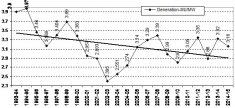Zero Rejection of Hydropower in India
Himanshu Thakkar is the coordinator of the South Asia Network on Dams, Rivers and People (SANDRP). He is blogs frequently at https://sandrp.wordpress.com and can be contacted at ht.sandrp@gmail.com
The Indian government continues to set ambitious hydropower targets, even though evidence suggests prudence in taking decisions regarding hydropower projects. In 2015, India added 1,824 Megawatt (MW) of large hydropower capacity. The country now has 42,641 MW hydropower capacity, according to official government data published at the end 2015.

But underneath the numbers lies a troubling truth: Affected people have no role or involvement in planning dams, and most often they benefit little from these projects. It’s no surprise then that many projects continue to face opposition from proletarian leaders, activists, and NGOs. Sadly hydropower developers have neither systems in place to engage with critics, nor a willingness to learn lessons from the past.
In another blog published last week, we analyzed some of the big-ticket projects commissioned in 2015. All of them have had a troubled track record, and most continue to face serious problems even after commissioning. These include the 800 MW Kol Dam in Himachal Pradesh, the 450 MW Baglihar II in Jammu and Kashmir, and the 80 MW Lower Jurala Project in Telangana, among others. To read more about the project appraisal blunders; popular opposition to the projects; indefinite fasts; time and cost overruns; faulty designs as well as accidents and casualties, click here.
Why a Zero Rejection Rate?
Problems seem to arise at the initial stage of appraisal. In particular, the Union Ministry of Environment and Forests’ Expert Appraisal Committee (EAC) on River Valley and Hydropower Projects has an egregious record of taking lenient decisions around hydropower projects.
All hydropower projects above 25 MW require approval from this committee or its counterpart in states (projects of 25-50 MW). But the EAC has had a zero rejection rate. It’s been clearing a large number of dams and hydropower projects – so many, in fact, that they far exceed the need, justification or carrying capacity of the river basins.
Even when the EAC did not agree to approve a few projects instantaneously in 2015, it asked for reformulations of the proposals. Moreover, there is little transparency and no public scrutiny. Often the project documents are not put up on their website (as mandated for informed public participation), and some projects are discussed and recommended without ever appearing on the meeting agenda.
The rapid approvals process also lead to costly consequences: poor scoping, appraisal and decisions. Poor appraisal can lead to expensive delays – the work at Lower Subansiri Hydropower project has continued to remain stalled for four years as of Dec 16, 2015.
Projects with Diminishing Returns
We’re also seeing a troubling pattern of diminishing returns with the installed capacity the country does have. The basic purpose of building hydropower projects is, of course, the generation of electricity. Given that, we’ve attempted to study how India’s hydropower projects performed in 2015.

Our earlier analysis has shown that the returns from hydropower projects in India are diminishing in different respects. Worryingly, the trend continues in 2015. During the year India’s large hydropower projects, as per the data from Central Electricity Authority, generated 129.11 BU (Billion Units, one unit equals one kilowatt hour). In 2014, they generated 130.8 BU. So, even though installed capacity in 2015 went up by 1,824 MW, generation actually decreased by 1,636 million units. But government agencies are not even trying to understand why this is happening.
Another unique selling proposition of hydropower claims that dams can provide peaking power, i.e. generate electricity in hours when demand is highest. But there is no agency either monitoring or trying to optimize peaking power from these projects, which is extremely worrying.
Let’s take a snapshot review of the situation. A look at the data from the daily Power Supply reports of the Northern Region Load Despatch Centre shows that on Dec 31, 2015, the region had a peaking shortage of 1,529 MW. (Northern Region, incidentally, should give us the best illustration in this regard since it has, at 18,815 MW, the highest hydropower capacity among all regions of India.) But on Dec 31 2015, about 60% of the hydropower capacity was not providing peaking power in this region, though it was supposed to be. During this time, rivers have lean flows and hence all the more reason for run of river projects to operate in peaking mode. The Northern region had only 1,529 MW of peaking shortage, which could have been easily provided by optimum operations of these projects. This tells us that we do not really need more hydro, since the current capacity is sufficient to cater to our peaking needs, if it were operated optimally and in the expected manner.
This year-end review of hydropower projects in India tells us that our decision making surrounding hydropower projects is flawed, and that we can and must change the way the decision-making system in functioning. We’re also deeply concerned that the power generation performance of hydropower projects continues to diminish, and although we do not need additional hydropower for peaking power, the government maintains ambitious targets, all of which will impact riverine ecosystems and the communities dependent on them. This becomes all the more important in changing climate, which increases the vulnerability of the already fragile Himalayan ecosystems. Projects that impact the health of our rivers need to be given greater thought and scrutiny.
This post is a modified version of a blog published here on January 8, 2016


